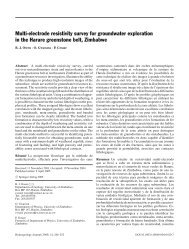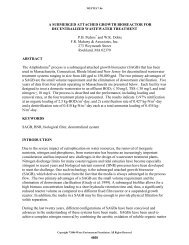Species diversity in the Florida Everglades, USA - Environmental ...
Species diversity in the Florida Everglades, USA - Environmental ...
Species diversity in the Florida Everglades, USA - Environmental ...
Create successful ePaper yourself
Turn your PDF publications into a flip-book with our unique Google optimized e-Paper software.
266 M. T. Brown et al. Ecosystem bio<strong>diversity</strong> <strong>in</strong> <strong>the</strong> <strong>Florida</strong> <strong>Everglades</strong><br />
7). The ecological consequences of <strong>in</strong>creas<strong>in</strong>g population<br />
of <strong>in</strong>troduced feral cats, dogs, and pigs, while of m<strong>in</strong>or<br />
consequence on mammal populations, may have signifi -<br />
cant consequences to o<strong>the</strong>r wildlife populations.<br />
Introduced species. The South <strong>Florida</strong> ecosystem, and<br />
<strong>the</strong> <strong>Florida</strong> <strong>Everglades</strong> <strong>in</strong> particular, is a regional hot-spot<br />
for <strong>in</strong>vasive exotic taxa. The orientation and length of <strong>the</strong><br />
<strong>Florida</strong> pen<strong>in</strong>sula result <strong>in</strong> many of <strong>the</strong> species native to<br />
<strong>the</strong> South <strong>Florida</strong> region be<strong>in</strong>g at <strong>the</strong> southward extent of<br />
<strong>the</strong>ir habitat range. An estimated 221 species of <strong>in</strong>troduced<br />
plants have grow<strong>in</strong>g or naturalized populations <strong>in</strong><br />
<strong>the</strong> region, perhaps as a result of this geographic condition<br />
coupled with <strong>the</strong> substantial changes <strong>in</strong> regional hydrology<br />
and <strong>the</strong> large human population. Listed <strong>in</strong> Table<br />
10 are some of <strong>the</strong> more signifi cant adventive plant taxa.<br />
Among <strong>the</strong> most expensive, both with respect to ecological<br />
and fi nancial costs, are melaleuca (Melaleuca qu<strong>in</strong>quenervia)<br />
and Brazilian pepper (Sch<strong>in</strong>us tereb<strong>in</strong>thifolius);<br />
both are <strong>in</strong>creas<strong>in</strong>g coverage, particularly <strong>in</strong><br />
disturbed areas of <strong>the</strong> South <strong>Florida</strong> ecosystem.<br />
A number of non-native mammal species have been<br />
accidentally or <strong>in</strong>tentionally <strong>in</strong>troduced <strong>in</strong> South <strong>Florida</strong>.<br />
Layne (1974) listed <strong>the</strong> follow<strong>in</strong>g species as known or<br />
suspected to have become established <strong>in</strong> south <strong>Florida</strong>:<br />
N<strong>in</strong>e-banded armadillo (Dasypus novemc<strong>in</strong>ctus L<strong>in</strong>naeus),<br />
red-bellied squirrel, (Sciurus aureogaster) black rat<br />
(Rattus rattus), coyote (Canis latrans), red fox (Vulpes<br />
vulpes), and jaguarundi (Herpailurus yaguarondi). In addition,<br />
along <strong>the</strong> fr<strong>in</strong>ges of <strong>the</strong> <strong>Everglades</strong>, <strong>the</strong> feral dogs<br />
(Canis familiaris) and cats (Felis domesticus) are somewhat<br />
common.<br />
Exotic fi shes, of which <strong>the</strong>re are 32 established species<br />
and 43 additional observed species <strong>in</strong> <strong>the</strong> State of<br />
<strong>Florida</strong> (found at http://myfwc.com/Fish<strong>in</strong>g/Fishes/<br />
Exotic%20List.html on Mar. 7, 2005; P. Shafl and), <strong>in</strong>clude<br />
<strong>the</strong> walk<strong>in</strong>g catfi sh (Clarias batrachus), blue and<br />
spotted tilapia (Oreochromis aurea and Tilapia mariae),<br />
oscar (Astronotus ocellatus), and Mayan cichlid (Cichlasoma<br />
urophthalmus). These species pose a threat to native<br />
fi sh populations through predation and competition<br />
for nest<strong>in</strong>g sites (McCann et al., 1996). Similarly, <strong>the</strong> <strong>in</strong>troduced<br />
house fi nch (Carpodacus mexicanus), house<br />
sparrow (Passer domesticus), European starl<strong>in</strong>g (Sturnus<br />
vulgaris), monk parakeet (Myiopsitta monachus), iguana<br />
(Iguana iguana), Cuban tree frog (Osteopilus septentrionalis)<br />
and wild hog (Sus scrofa) are caus<strong>in</strong>g both physical<br />
damage and community shifts <strong>in</strong> <strong>the</strong> native ecosystems.<br />
O<strong>the</strong>r organisms whose impact is less well<br />
documented <strong>in</strong>clude Burmese pythons (Python molurus<br />
bivittatus), vervet monkeys (Cercopi<strong>the</strong>cus aethiops),<br />
and boa constrictors (Constrictor constrictor).<br />
Table 10. Most Dom<strong>in</strong>ant Invasive Plants (Thayer et al., 2000).<br />
Scientifi c Name Common Name<br />
Melaleuca qu<strong>in</strong>quenervia Melaleuca tree<br />
Lygodium microphyllum Old World climb<strong>in</strong>g fern<br />
Sch<strong>in</strong>us tereb<strong>in</strong>thifolius Brazilian pepper<br />
Casuar<strong>in</strong>a equisetifolia Australian p<strong>in</strong>e<br />
Colubr<strong>in</strong>a asiatica La<strong>the</strong>rleaf, Asian snakeroot<br />
Eichhornia crassipes Water hyac<strong>in</strong>th<br />
A systems approach to calculat<strong>in</strong>g bio<strong>diversity</strong><br />
Richness and <strong>diversity</strong>. Assessments of bio<strong>diversity</strong> at<br />
<strong>the</strong> ecosystem scale typically rely on counts of species <strong>in</strong><br />
different classes (e.g., avian richness or herbivore richness).<br />
Our <strong>in</strong>troduction to <strong>the</strong> <strong>diversity</strong> of <strong>the</strong> <strong>Everglades</strong><br />
illustrates <strong>the</strong> critical need for conservation, but raises<br />
several conceptual and practical problems related to describ<strong>in</strong>g<br />
and compar<strong>in</strong>g ecosystems and sett<strong>in</strong>g conservation<br />
priorities. First, bio<strong>diversity</strong> databases assembled<br />
from a variety of sources can be mislead<strong>in</strong>g when different<br />
areas have been sampled with different sampl<strong>in</strong>g <strong>in</strong>tensities,<br />
which leads to <strong>in</strong>herent collection bias, or observations<br />
reported with different confi dence (Peet, 1974;<br />
Fagan and Kareiva, 1997). Fur<strong>the</strong>r, while some correlation<br />
can be found between plant species richness and<br />
animal species richness, areas rich <strong>in</strong> plant species <strong>diversity</strong><br />
do not always co<strong>in</strong>cide with richness at o<strong>the</strong>r trophic<br />
levels (Mares, 1992). Consequently, bio<strong>diversity</strong> hotspots<br />
identifi ed based on richness at one trophic level alone<br />
may miss areas of major conservation importance<br />
(Mares, 1992; Harcourt, 2000; Kareiva and Marvier,<br />
2003). F<strong>in</strong>ally, when design<strong>in</strong>g conservation strategies<br />
us<strong>in</strong>g <strong>diversity</strong> as <strong>the</strong> <strong>in</strong>dicator of ecosystem service,<br />
<strong>the</strong>re is ambiguity <strong>in</strong> <strong>the</strong> defi nition of <strong>diversity</strong> (e.g., cladistics,<br />
species, genetic), which can lead to confounded<br />
conservation priorities (Angermeier and Karr, 2004).<br />
In addition, <strong>the</strong> effort to equate <strong>the</strong> number of different<br />
actors <strong>in</strong> an ecosystem with <strong>the</strong> functional value of<br />
that ecosystem is a perilous one: empirical studies have<br />
uncovered limited evidence to support this hypo<strong>the</strong>sis<br />
(although see Tilman and Down<strong>in</strong>g, 1994), and model<strong>in</strong>g<br />
studies suggest that ecosystem function can be ma<strong>in</strong>ta<strong>in</strong>ed<br />
with only a fraction of <strong>the</strong> species varieties (Grime,<br />
1997; Schwartz et al., 2000). Smith et al. (1993) suggest<br />
that conservation programs designed accord<strong>in</strong>g to species<br />
richness, and not evolutionary processes, will fail to<br />
protect <strong>the</strong> most critical habitat with respect to genetic<br />
<strong>in</strong>formation. Fur<strong>the</strong>r, and possible most important, simple<br />
counts of organism variety <strong>in</strong> a region fundamentally<br />
fail to capture <strong>the</strong> networks of ecological <strong>in</strong>teractions and<br />
feedbacks that produce ecosystem properties (e.g., productivity,<br />
stability) (Ulanowicz, 2001; Worm and Duffy,<br />
2003), which are frequently cited as one motivation for<br />
bio<strong>diversity</strong> conservation. Angermeier and Karr (1994)<br />
discuss problems with associat<strong>in</strong>g ecological <strong>diversity</strong>
















